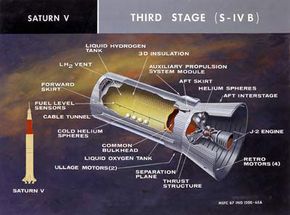The Apollo Launch Vehicle
The Saturn V launch vehicle packed a lot of power into its three-stage structure. The rocket consisted of three sections bolted together: The base section was stage I, above which was stage II and on top of which was stage III. At the very top of the rocket sat the Saturn V's instrument panel and control system, which automatically guided the sequence of ignitions required to launch the Apollo spacecraft into orbit.
Let's look at each of these sections in turn:
Advertisement
- Stage I was called the S-IC. It had five rocket engines that used liquid oxygen and kerosene as fuel. Each engine produced 1.5 million pounds (6,675,000 newtons) of thrust. Together, the engines could generate 7.5 million pounds (33,375,000 newtons) of thrust. Think of thrust as the strength of a rocket engine. This thrust pushed the entire vehicle assembly more than 36 miles (57.9 km) vertically at a speed of 9,030 feet (2,752 m) per second (fps). At that point, the S-IC's engines shut off. Explosive bolts connecting S-IC to the rest of the Saturn V vehicle detonated, jettisoning stage I into the Atlantic Ocean.
- Stage II (S-II) had five J-2 engines that together could produce 1,125,000 pounds (5,006,250 newtons) of thrust. In this stage, the Saturn V accelerated to a speed of 22,746 fps (6,932 meters per second). The S-II carried the rest of the vehicle up to an altitude of 101 miles (162.5 kilometers) before shutting off. Like the S-IC, the S-II then separated from the rest of the vehicle by igniting the explosive bolts connecting it.
- Stage III was called the S-IVB, which NASA previously used on the Saturn IB launch vehicle. This final stage had a single J-2 rocket engine that could provide 225,000 pounds (1,001,250 newtons) of thrust. It was this stage of the Saturn V rocket that put the Apollo spacecraft into Earth's orbit. Once in orbit, the engines powered down temporarily. When the spacecraft achieved the proper alignment after a few rotations around the Earth, the engines would reignite. The resulting thrust guided the Apollo spacecraft into a lunar trajectory. After this second ignition, the S-IVB separated from the spacecraft. The S-IVB also housed the Saturn V's instrument panel at the far forward end (the "top" of the Saturn V).
- The instrument panel included guidance and navigation systems, measuring devices, power supplies and telemetry transmitters. Telemetry refers to technology that can gather data and transmit it to another location automatically. In this case, the information gathered included velocity and spacecraft orientation, and the instruments transmitted the data to crews on the Earth.
While launches were impressive to watch and relied on a complex series of controlled ignitions, they were just the tip of the iceberg for the Apollo missions. Where were the astronauts during the launch, and from where did they control the spacecraft? Find out in the next section.
